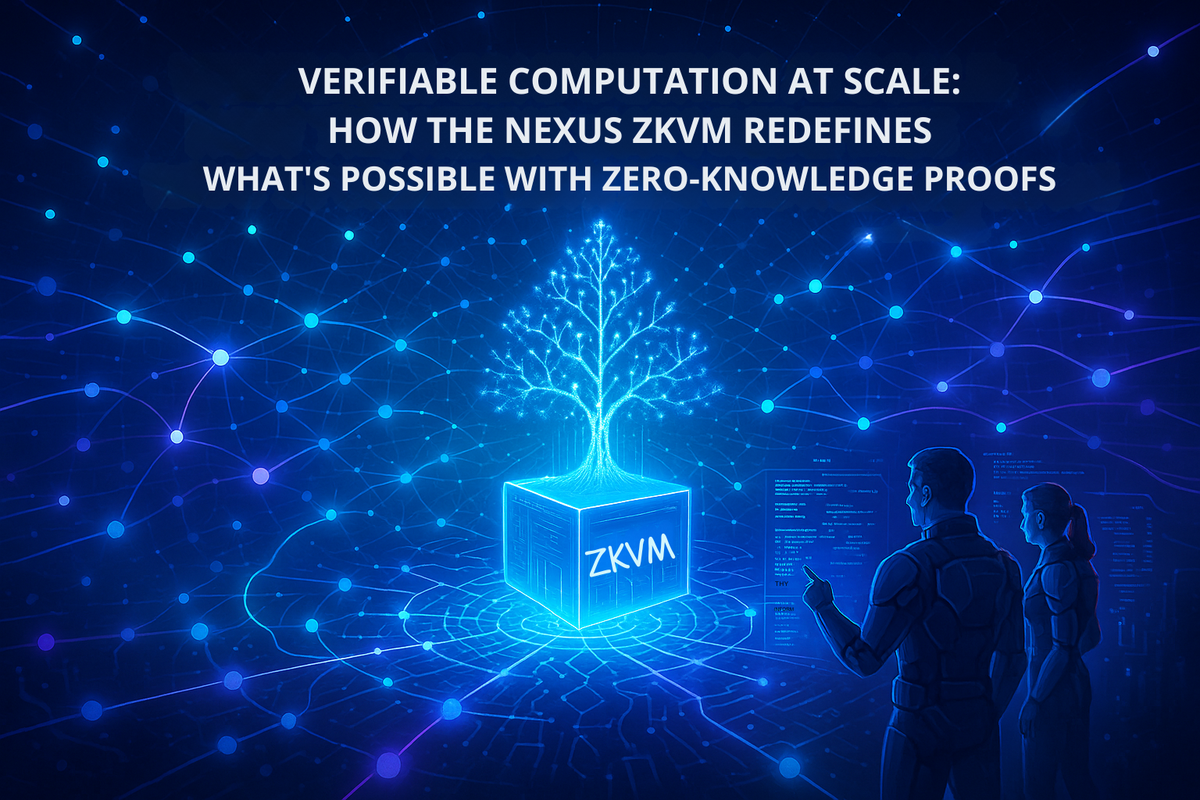🚀 Verifiable Computation at Scale: How the Nexus zkVM Redefines What’s Possible with Zero-Knowledge Proofs 🧑💻

The promise of Web3 hinges on decentralized control, giving users unprecedented power over their data and digital assets. But with this shift comes a critical need for trust and verification in a system without central authorities. Zero-Knowledge Proofs (ZKPs) offer a powerful solution, allowing one party to prove a computation was done correctly without revealing any underlying data.
However, applying ZKPs to complex, real-world programs—the kind that power sophisticated dApps and services—has long been a significant hurdle. This is where Zero-Knowledge Virtual Machines (zkVMs) come in, designed to prove the correct execution of any program running on a virtual computer. Among the most advanced efforts in this space is Nexus, with its purpose-built Nexus zkVM, engineered to make verifiable computation both scalable and practical for real-world applications. Read more about other zkVM infrastructure like Succinct
🤖 What Is the Nexus zkVM?
At its core, the Nexus zkVM is a universal prover: a system capable of generating zero-knowledge proofs for any arbitrary computer program. Unlike traditional ZKP systems that require developers to create bespoke circuits for each specific computation—an approach akin to building a new ASIC per task—the Nexus zkVM allows general-purpose code to be verified cryptographically using a universal virtual CPU architecture.
Its real innovation, however, lies in its scalability. The zkVM is designed from the ground up to efficiently handle massive computations, spanning billions or even trillions of CPU cycles, while maintaining speed, succinctness, and trustlessness.
🌐 Moving Beyond Static Circuits: What Makes Nexus zkVMs Different
| Feature | ASIC-based ZK (Static Circuits) | Early CPU-based ZK VMs | Nexus zkVM |
|---|---|---|---|
| Flexibility | Low (one circuit per program) | Moderate (fixed universal VM circuit) | High (modular VM, customizable IR, pluggable layers) |
| Proving Scalability | Low (monolithic, bounded by circuit size) | Low–Moderate (slow, limited recursion) | High (parallel folding + recursive IVC with SNARK wrap) |
| Ease of Development | Low (hardware-specific) | Moderate (Rust or Cairo, but VM-specific) | High (Rust + IR + EVM/Wasm dev paths) |
| Dynamic Execution Support | Poor | Moderate (limited state control) | Excellent (native dynamic control via VM+IR) |
| Proof Aggregation | N/A | Expensive recursion (STARK-heavy) | Efficient folding-based recursion + SNARK compression |
Traditional static-circuit systems make ZK proving inaccessible to most developers. Every loop size, memory allocation, and control structure must be fixed ahead of time, with minimal room for dynamic logic. Early VM-based approaches aimed to solve this but stumbled on scaling. They relied heavily on expensive recursive SNARKs and massive memory resources to glue together many small proof segments, often requiring hundreds of gigabytes of RAM.
Nexus takes a fundamentally new route: designing the zkVM and its infrastructure from scratch to scale horizontally via parallel proof generation, eliminating the bottlenecks that stifled previous efforts.
zkVMs in Focus: A Technical Comparison of Nexus, RISC Zero, and Cairo
| Feature | Nexus zkVM | RISC Zero | Cairo |
|---|---|---|---|
| Instruction Model | Custom 3-op ISA + Intermediate Representation (IR) | RISC-V ELF with custom opcodes | Cairo assembly (custom VM language) |
| Recursive Support | Yes — efficient folding recursion via Nova/HyperNova | Yes — STARK-based recursion, enhanced with Bonsai | Historically no; recursion added in Cairo 1.x roadmap |
| Distributed Proving | Native — via role-based node architecture | Not built-in; achievable with tooling like Bonsai | Not supported |
| Modular Proof Phases | Yes — composable layers with pluggable final compression (e.g., SNARKs) | No — monolithic circuit design | No — tightly coupled to Cairo/STARK toolchain |
| Co-Processors | Yes — supports domain-specific compute modules (e.g., zkML, LLMs) | Limited (e.g., hashing); extensibility in roadmap | None |
| Best Use Cases | zkML, game logic, zkRollups, modular execution environments | General-purpose verifiable compute, privacy-preserving infra | StarkNet dApps, Cairo-native contracts |
| Proving System | Folding-based IVC (Nova/HyperNova) + SNARK final proof (e.g., Groth16/PLONK) | zk-STARKs (transparent, scalable, but large proof sizes) | zk-STARKs (scalable, Cairo-native, but limited interop) |
| Developer Experience | High — modular IR stack, futureproof architecture | Rust + RISC-V familiarity required | Custom language (Cairo); moderate to steep learning curve |
🔧 Inside the Nexus zkVM: A Five-Stage Pipeline for Verifiable Computation
The Nexus zkVM’s architecture unfolds in five coordinated stages, each optimized for scalability and modularity:
- 🔑 One-Time Setup
A virtual machine architecture (NVM) is defined, generating public parameters. Developers can customize this architecture with zkVM co-processors—dedicated circuits for operations like hashing or signature verification that accelerate specific tasks while maintaining flexibility. - 💻 Compilation
Programs written in high-level languages (like Rust) or compiled from EVM/Wasm are translated into the NVM instruction set. This architecture is intentionally minimal and provable, avoiding the complexity of real-world CPUs like x86. - ⚙️ Execution
The compiled code runs on the NVM, generating an execution trace—a cryptographic record of every instruction executed. This trace becomes the foundation for proof generation. - 🗜️ Compression
The final aggregated proof is still large, so a compact zk-SNARK is used to compress it into a small, easily verifiable proof suitable for posting on chains like Ethereum. This allows anyone to confirm massive computations in milliseconds.
🔄 Folding (Parallel Proof Aggregation)
Instead of generating a single, monolithic proof, the zkVM divides execution into smaller segments. Using advanced recursive proof schemes like Nova, CycleFold, and HyperNova, these segment proofs are folded into an aggregated tree structure. This process is highly parallelizable and intended to be distributed across the Nexus Network—a global network of provers.
This implements a Proof-Carrying Data (PCD) model, enabling verifiable computations to span many machines without centralized trust.
🌍 Real-World Use Cases for the Nexus zkVM
This architecture unlocks powerful new use cases previously deemed impractical:
- 🔗 Smart Contract Offloading
Off-chain or Layer 2 computation of complex contract logic that would be too costly or slow on-chain. - 🤖 AI & Machine Learning Verification
Verifying the execution and outputs of ML models to ensure correctness and eliminate tampering. - 🎮 Gaming & Simulation
Running and proving the correctness of game mechanics or scientific simulations in real-time. - 🖥️ General-Purpose Computation
Writing ordinary programs in Rust or other familiar languages and proving their results—without needing to understand circuit design.
🛣️ The Road Ahead: A Verifiable Future
Nexus has already released a full open-source implementation of the zkVM and the Nexus Network in Rust. Key proof systems—Nova, CycleFold, HyperNova, and compression SNARKs—are included. While features like non-uniform IVC for co-processors and standard I/O interfaces are still under development, the foundations are solidly in place.
The Nexus zkVM doesn’t just make proving large computations possible—it makes them practical, scalable, and trustless. In doing so, it lays the groundwork for a new era of verifiable computation at Internet scale—where mathematical proof backs every digital process, from smart contracts to simulations to AI models.
Related Article
Beyond the EVM: How zkVMs are Redefining Web3 Scalability
ZK Compression on L2s: A Deep Dive into How Starknet and zkSync Are Reducing Costs
🔍 SUCCINCT SP1 ZKVM: MAKING ZERO-KNOWLEDGE PROOFS ACCESSIBLE TO RUST DEVELOPERS



Comments ()